
【Rで統計学#8】分散分析
記事の目的
R言語を使用して、分散分析について実装していきます。
目次
1 使用するライブラリ
install.packages("dplyr") # 一度もインストールしていない場合
install.packages("ggplot2") # 一度もインストールしていない場合
install.packages("tidyr") # 一度もインストールしていない場合
install.packages("stringr") # 一度もインストールしていない場合
install.packages("gridExtra") # 一度もインストールしていない場合
library(dplyr)
library(ggplot2)
library(tidyr) # gather()
library(stringr) # str_detect()
library(gridExtra) # grid.arrange()
2 一元配置分散分析
2.1 データの作成
set.seed(10) 講義A <- rnorm(10, 600, 100) %>% round() 講義B <- rnorm(10, 650, 100) %>% round() 講義C <- rnorm(10, 700, 100) %>% round() dataA <- data.frame(講義A, 講義B, 講義C) dataA %>% head() dataA %>% apply(2, mean)
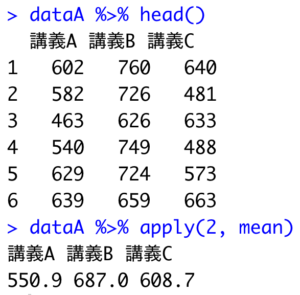
2.2 データの変形
dataA_all <- dataA %>% gather(key=講義, value = 点数, 講義A, 講義B, 講義C) dataA_all %>% head() dataA %>% apply(2, mean)
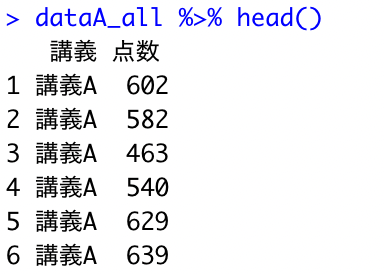
2.3 データの可視化
dataA_all %>% ggplot() + geom_point(aes(講義, 点数)) + theme_classic(base_family = "HiraKakuPro-W3") + theme(text=element_text(size=40)) + labs(x=NULL, title="データのプロット")
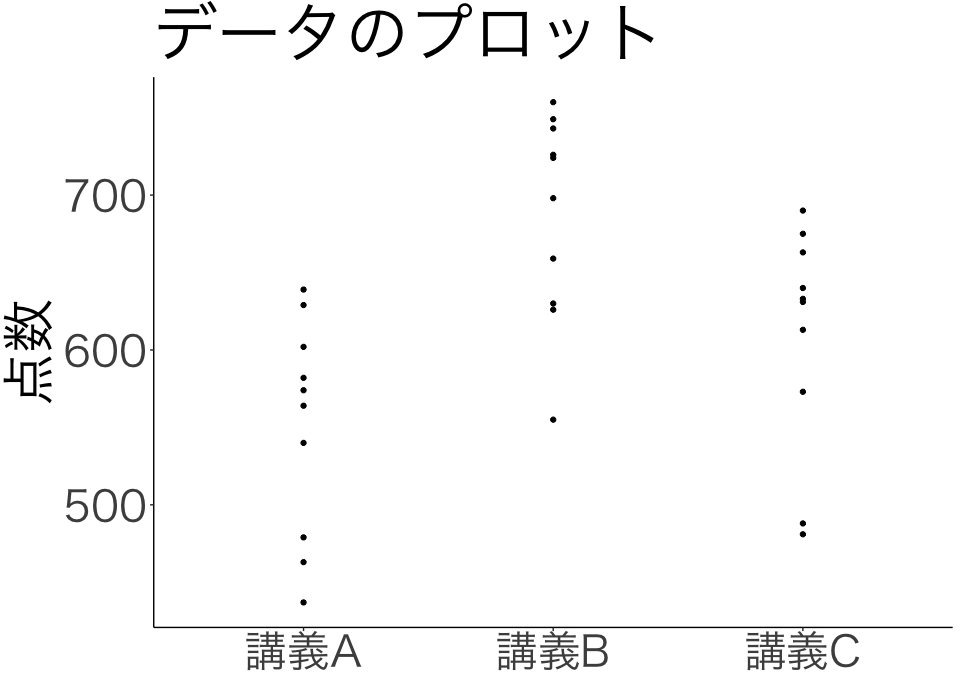
2.4 分散分析実装
anova(lm(data=dataA_all, 点数~講義))

3 二元配置分散分析
3.1 データの作成
set.seed(10) 講師1講義A <- rnorm(10, 600, 100) %>% round() 講師1講義B <- rnorm(10, 650, 100) %>% round() 講師1講義C <- rnorm(10, 700, 100) %>% round() 講師2講義A <- rnorm(10, 600, 100) %>% round() 講師2講義B <- rnorm(10, 600, 100) %>% round() 講師2講義C <- rnorm(10, 600, 100) %>% round() dataB <- data.frame(講師1講義A, 講師1講義B, 講師1講義C, 講師2講義A, 講師2講義B, 講師2講義C) dataB %>% head()

3.2 データの変形
dataB_new <- dataB %>% gather(key=講義, value = 点数, 講師1講義A, 講師1講義B, 講師1講義C, 講師2講義A, 講師2講義B, 講師2講義C) dataB_new %>% head()
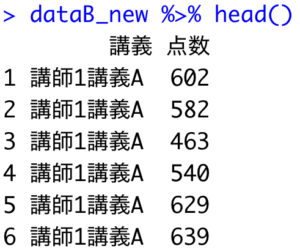
data_new <- dataB %>% gather(key=講義, value = 点数, 講師1講義A, 講師1講義B, 講師1講義C, 講師2講義A, 講師2講義B, 講師2講義C) %>% mutate(講師=ifelse(str_detect(講義, "講師1"), "講師1", "講師2")) %>% mutate(講義=ifelse(str_detect(講義, "講義A"), "講義A", ifelse(str_detect(講義,"講義B"), "講義B", "講義C"))) data_new %>% head()
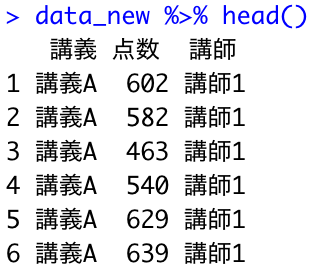
3.3 データの平均
mu1 <- data_new %>% group_by(講義) %>% summarise(mu = mean(点数)) mu2 <- data_new %>% group_by(講師) %>% summarise(mu = mean(点数)) mu <- dataB %>% apply(2, mean) %>% as.data.frame() mu1 ; mu2 ; mu
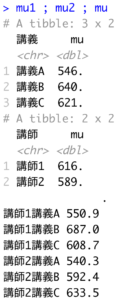
3.4 データの可視化
p1 <- ggplot() + geom_point(aes(data_new$講義, data_new$点数)) + theme_classic(base_family = "HiraKakuPro-W3") + theme(text=element_text(size=30)) + geom_point(aes(mu1$講義, mu1$mu), size=5, col="red") + labs(title="データプロット", x=NULL, y="点数") p2 <- ggplot() + geom_point(aes(data_new$講師, data_new$点数)) + theme_classic(base_family = "HiraKakuPro-W3") + theme(text=element_text(size=30)) + geom_point(aes(mu2$講師, mu2$mu), size=5, col="blue") + labs(title="データプロット", x=NULL, y="点数") grid.arrange(p1, p2, nrow=1)
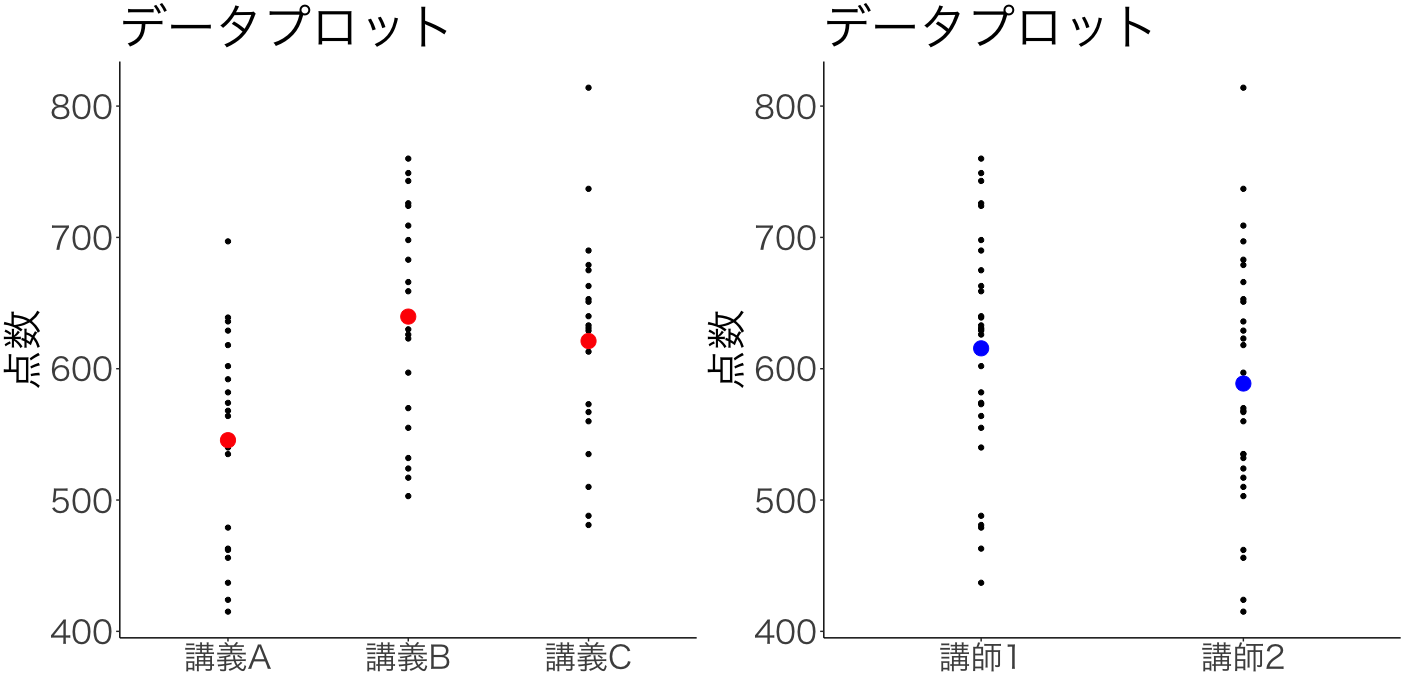
ggplot() + geom_point(aes(dataB_new$講義, dataB_new$点数)) + theme_classic(base_family = "HiraKakuPro-W3") + theme(text=element_text(size=30)) + geom_point(aes(rownames(mu)[1:3], mu$.[1:3]), size=5, col="red") + geom_point(aes(rownames(mu)[4:6], mu$.[4:6]), size=5, col="blue")+ labs(title="データプロット", x=NULL, y="点数")

3.5 二元配置分散分析実装
summary(aov(data=data_new, 点数~講義+講師))

summary(aov(data=data_new, 点数~講義*講師))




